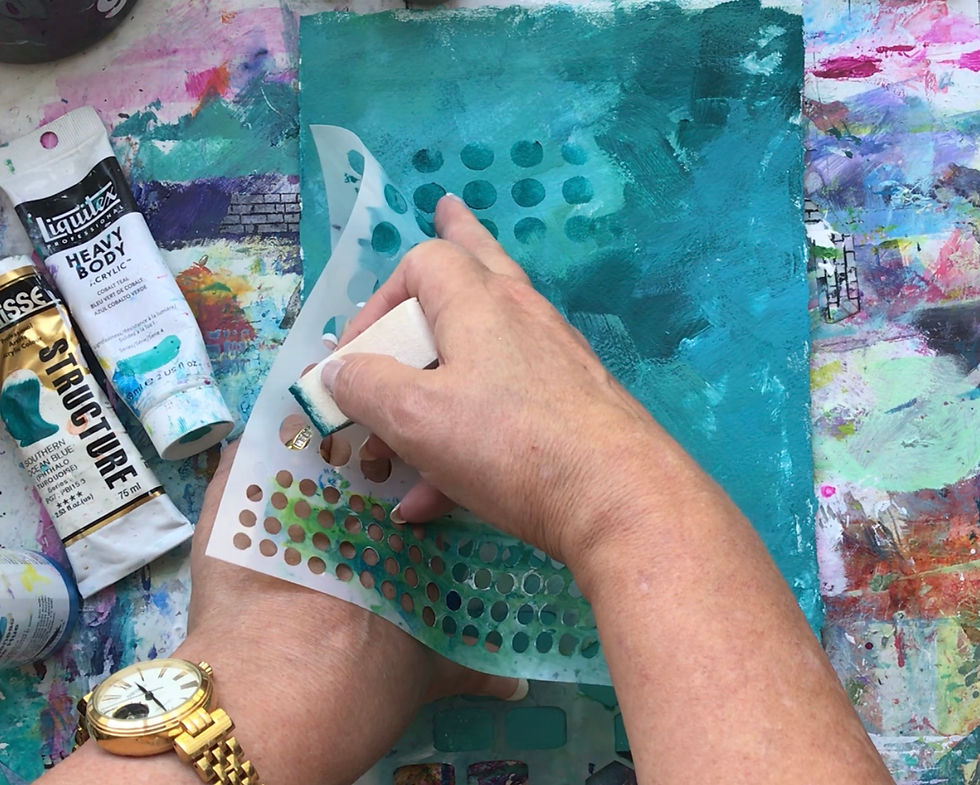
There is nothing more intimidating to an artist than the blank canvas or blank page.
It looms on your easel or desk a million possibilities, a myriad of questions, the great unknown...now what?
Well, first thing, breathe, and don't worry, I have got 6 techniques guaranteed to help you overcome that fear of the blank canvas/page and get your art started.
1. Cover the canvas or page with a mid-tone colour
Using one of the following colours: blue/violet(ultramarine blue), phthalocyanine blue(primary blue), blue/green, green, red/orange or magenta red(primary red) and white and black gesso make tints, tones and shades of that colour.
Using a one inch brush in a criss cross motion cover the whole canvas/page.
Follow this step by adding visual texture with lines made with pencils or charcoal, marks made from household objects (like a loo roll or bubble wrap) or with stencils.

Follow this by painting your painting in the opposite colour (for example with a blue/green background your painting would be with red/oranges) leaving hints of the blue/green to show through for visual harmony.
2. Use Collage
Which means grab any papers with visual texture (patterns) or actual texture (rice papers, specialty papers) and cover the whole or part of the canvas/page with paper, attached using a soft gel matte medium (as it is archival).
If only covering part of the canvas/page think of a compositional layout to use as your base. For example you attach your papers in a cruciform (cross) layout over your canvas/page as I have done in the 2 paintings below.
In the painting above, I used rice papers as a base for the texture for my rocks and trees in a cruciform compositional layout.
Below I added black and white pattened paper in a cruciform composition then painted over them with a glaze (acrylic paint with acrylic glazing liquid) and scratched back into the paint to reveal the patterns underneath.
3. Start with a Colour Scheme
Pick one of the standard colour schemes
Analogous: any 3 colours next to each other on the colour
wheel (eg. blue, blue/green, green)
Complementary: 2 colours opposite each other on the colour wheel.
(eg. blue and orange)
Triadic: any 3 colours spaced evenly around the colour
wheel(eg. red, blue, yellow)
Remember to use one of the colours as your dominant colour, about 80% of the painting and the other colours about 20% of your painting.
4. Use a Texture Paste
Cover the whole canvas with a texture paste (or a thick layer of gesso) and carve into it with the end of your paint brush or your palette knife.
Remember to repeat shapes and run the pattern off the edge. Add a dark glaze and wipe off most so it just remains in the valleys of the texture paste, to add depth and value.
On this journal page, I used a thick layer of gesso and carved a repeating pattern of hearts and the word 'Love' into it, glazed with a dark blue then added an acrylic glaze of blue/violet and red/violet and outlined shapes with a white pen.
5.Composition
Start by picking a composition. We've already talked about a cruciform composition but there are many others such as asymmetrical (more on one side than the other), symmetrical (even on either side of the midline), horizontal (most landscapes are horizontal, lines going across the page) or vertical(lines going up the page), alphabet shapes (C, S, L, O, T, U, Y, or Z compositions that are the shape of the letter).
Above is an asymmetrical composition in ground crystal watercolours.
6. Canvas/page as a Doorway to Creativity
Use the canvas/page as a doorway, a place where your art can start, by writing all over it using a black marker.
Empty your mind and your frustrations on to the canvas/page in a stream of consciousness (writing continuously without stopping) and you'll be surprised with what you come up with and the doors to your creativity will open.
Paint over it leaving some to show through in your finished work as visual texture.
For more information on getting your art started with 'ArtStart' click here to go my website or to watch your free artist classes online.








Comments